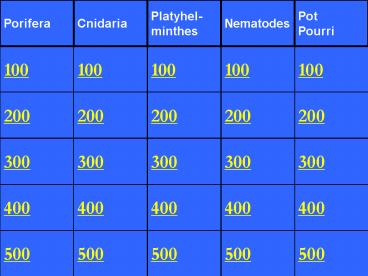Porifera - PowerPoint PPT Presentation
1 / 51
Title: Porifera
1
Porifera
Cnidaria
Platyhel- minthes
Nematodes
Pot Pourri
100
100
100
100
100
200
200
200
200
200
300
300
300
300
300
400
400
400
400
400
500
500
500
500
500
2
Members of this phylum are commonly called this
3
Sponges
4
They generally produce both sperm and egg. This
makes them ___.
5
hermaphrodites
6
Fresh water sponges produce these spore-like
formations to survive winters
7
Gemmules
8
The cells that line the inside and have flagella
9
Collar cells
10
Hard, spikey structures formed by the amoebacytes
11
Spicules
12
The 3 main classes in this phylum
13
Jellyfish, anemones, and corals
14
The body form of a jellyfish
15
Medusa
16
The stingers typical of all members of this
phylum
17
Nematocysts
18
The sessile body form
19
Polyp
20
The class that makes large rock-like structures
21
Corals
22
The common name for this phylum
23
Flat worms
24
The free-living organism of this phylum known for
their ability to regenerate
25
Planaria
26
The flatworm commonly found in the intestines
27
Tapeworm
28
The flatworm with a complex life cycle involving
2 or more hosts
29
Flukes
30
The head of a tapeworm with suckers and hooks
31
Scolex
32
The common name for this phylum
33
Roundworms
34
The number of openings to the gut of nematodes
35
2 (mouth and anus)
36
The reason that roundworms wriggle
37
They only have circular muscles
38
Some roundworms are parasites, the rest are this
39
Free-living
40
Roundworms do not have a true coelom, they have
this
41
Pseudocoelom
42
A body cavity lined with mesoderm
43
Coelom
44
The cavity in a cnidarian
45
Gastrovascular cavity
46
The body segments of a tapeworm
47
Proglottids
48
The planarians protruding mouthpart
49
Pharynx
50
___ have flat, solid bodies
51
Flatworms































